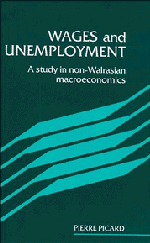Book contents
- Frontmatter
- Contents
- Acknowledgements
- Introduction
- 1 Price rigidities and temporary equilibrium
- 2 Wage rigidity and short-run macroeconomic equilibrium
- 3 Real wages and the inflation—unemployment dilemma
- 4 External constraint, oil shock and economic policy
- 5 Implicit contracts and unions
- 6 Introduction to efficiency wage models
- 7 Efficiency wages, employment fluctuations and fiscal policy
- 8 Labour market dualism, efficiency wages and optimal taxation
- Notes
- References
- Author index
- Subject index
1 - Price rigidities and temporary equilibrium
Published online by Cambridge University Press: 28 October 2009
- Frontmatter
- Contents
- Acknowledgements
- Introduction
- 1 Price rigidities and temporary equilibrium
- 2 Wage rigidity and short-run macroeconomic equilibrium
- 3 Real wages and the inflation—unemployment dilemma
- 4 External constraint, oil shock and economic policy
- 5 Implicit contracts and unions
- 6 Introduction to efficiency wage models
- 7 Efficiency wages, employment fluctuations and fiscal policy
- 8 Labour market dualism, efficiency wages and optimal taxation
- Notes
- References
- Author index
- Subject index
Summary
The main distinction between Keynesian and neoclassical macroeconomic approaches probably lies in their different appraisals of the competitive markets' ability to spontaneously reach an efficient allocation of resources in the short run. Keynes himself conceded that in the long run the market's mechanisms may lead to a certain kind of efficiency but he contested the practical consequences of this proposition, since the regulating processes furthering such an hypothetic long-run optimum are often too weak or slow acting to be satisfactory. The general equilibrium theory, as rigorously formulated by Arrow and Debreu (1954) and Debreu (1959), does not allow any distinction between the short and the long run that can be used directly when dealing with these issues. Indeed, the Arrow—Debreu model deals with an intertemporal economy but it brings forward hypotheses that make it pointless to distinguish between the short and the long run: for each product and each date, it is assumed that there exists a complete set of competitive contingent markets. Within such a context, under the usual assumptions of general competitive equilibrium theory, there exists an intertemporal equilibrium which is an ex ante Pareto optimum. In order to emphasize the disruptive factors and inefficiencies that might affect the economy in the short run, macroeconomic theory needs a much more realistic context, where some of the previous assumptions are not established and, more particularly, where time actually matters because markets are incomplete.
- Type
- Chapter
- Information
- Wages and UnemploymentA Study in Non-Walrasian Macroeconomics, pp. 6 - 45Publisher: Cambridge University PressPrint publication year: 1993



